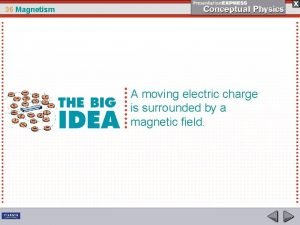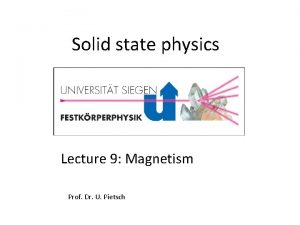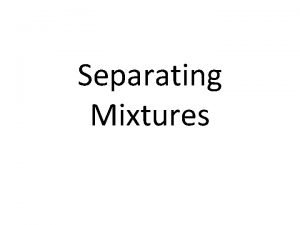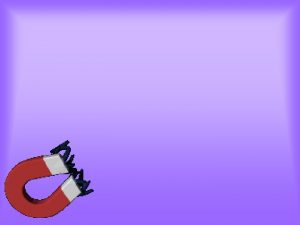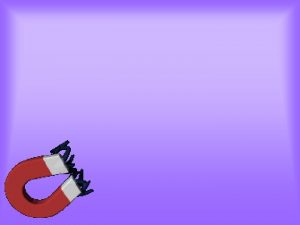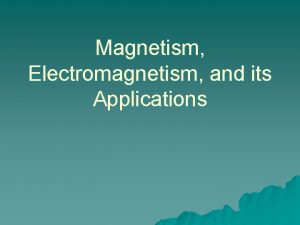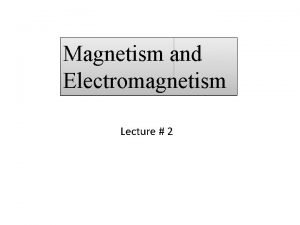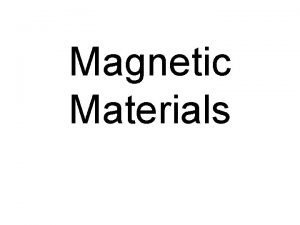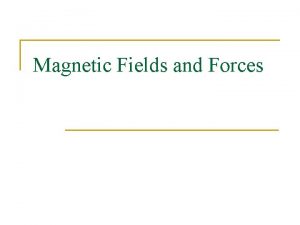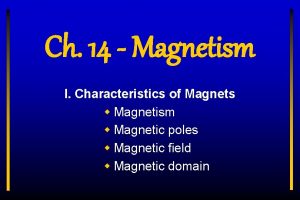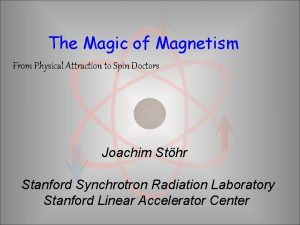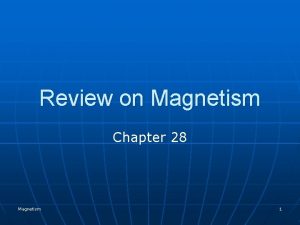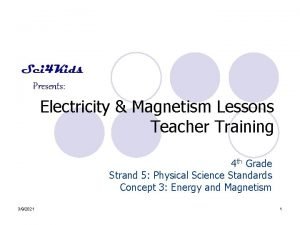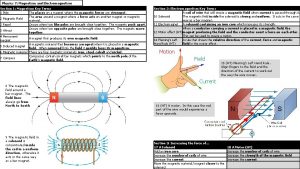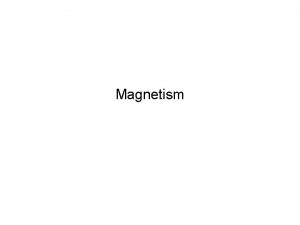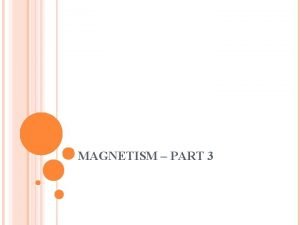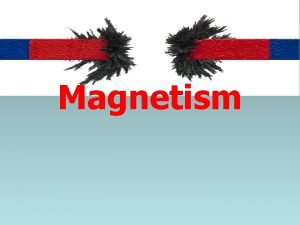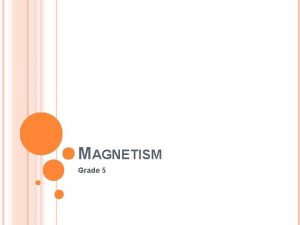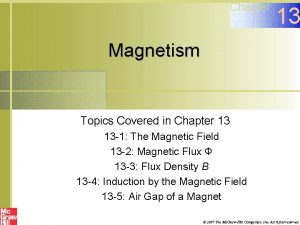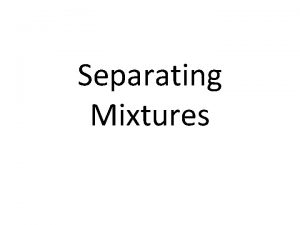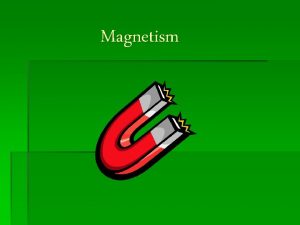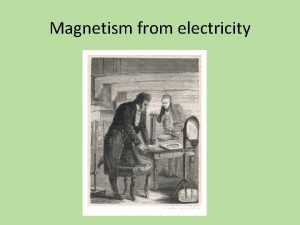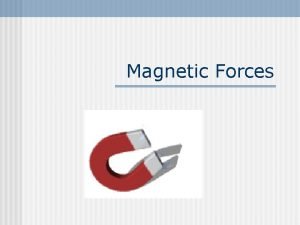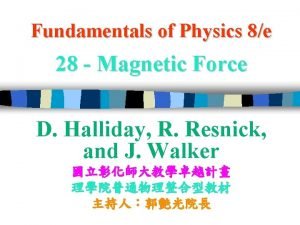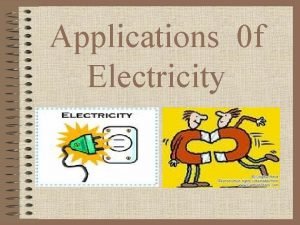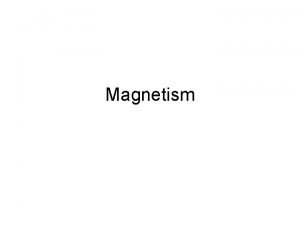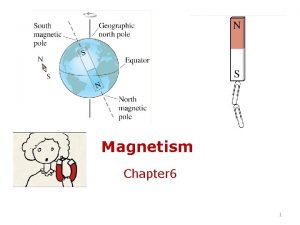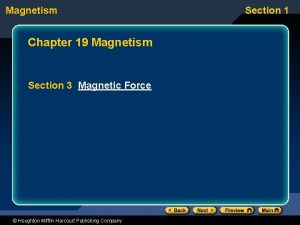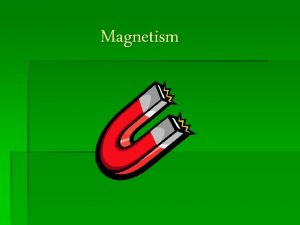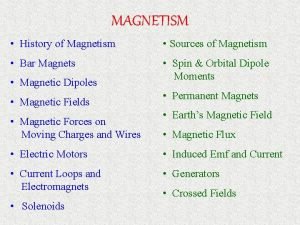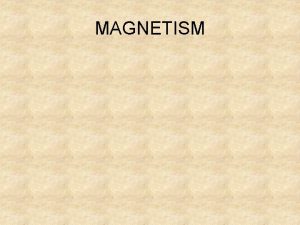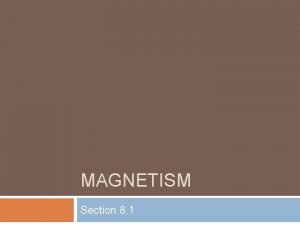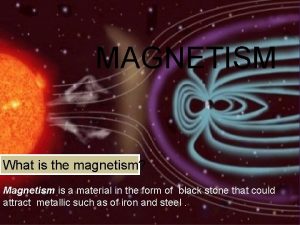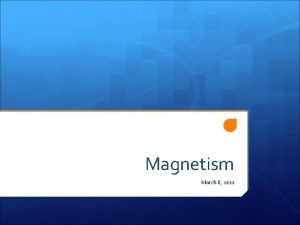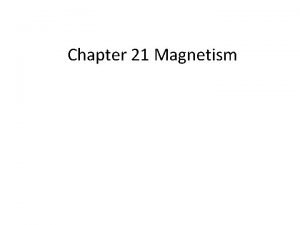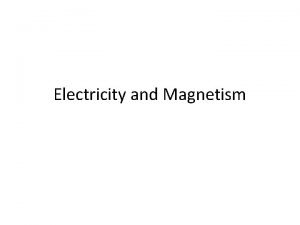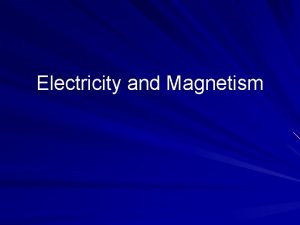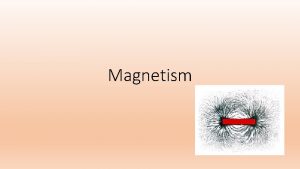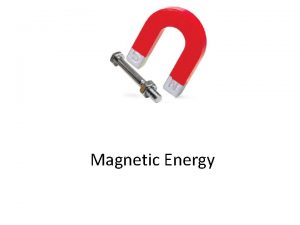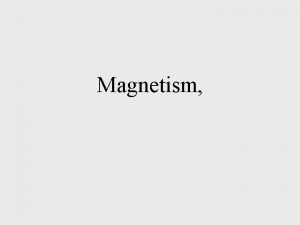Magnetism Chapter 28 Magnetism 1 Chapter 28 Magnetic














































- Slides: 46

Magnetism Chapter 28 Magnetism 1

Chapter 28 Magnetic Fields In this chapter we will cover the following topics: Magnetic field vector Magnetic force on a moving charge Magnetic field lines Motion of a moving charge particle in a uniform magnetic field Magnetic force on a current carrying wire Magnetic torque on a wire loop Magnetic dipole, magnetic dipole moment Hall effect Cyclotron particle accelerator Magnetism (28 – 1) 2

Magnetism was known long ago. Magnetism 3

New Concept The Magnetic Field – We give it the symbol B. – A compass will line up with it. – It has Magnitude and direction so it is a VECTOR. • There are some similarities with the Electric Field but also some significant differences. Magnetism 4

Magnetism (28 – 2) 5

Magnetism • Refrigerators are attracted to magnets! Magnetism 6

Where is Magnetism Used? ? • Motors • Navigation – Compass • Magnetic Tapes – Music, Data • Television – Beam deflection Coil • Magnetic Resonance Imaging • High Energy Physics Research Magnetism 7

(28 – 8) Cathode Anode Magnetism 8

Magnet Demo – Compare to Electrostatics N Magnet What Happens? ? S Pivot Magnetism 9

Results - Magnets S N Shaded End is NORTH Pole Shaded End of a compass points to the NORTH. Magnetism • Like Poles Repel • Opposite Poles Attract • Magnetic Poles are only found in pairs. – No magnetic monopoles have ever been observed. 10

Magnets ld Fie c eti n g Ma Cutting a bar magnet in half produces TWO bar magnets, each with N and S poles. Magnetism 11

Consider a Permanent Magnet N S The magnetic Field B goes from North to South. Magnetism 12

Introduce Another Permanent Magnet N N S pivot S The bar magnet (a magnetic dipole) wants to align with the B-field. Magnetism 13

Field of a Permanent Magnet N N S S The south pole of the small bar magnet is attracted towards the north pole of the big magnet. The North pole of the small magnet is repelled by the north pole of the large magnet. The South pole pf the large magnet creates a smaller force on the small magnet than does the North pole. DISTANCE effect. The field attracts and exerts a torque on the small magnet. Magnetism 14

Field of a Permanent Magnet N N S S The bar magnet (a magnetic dipole) wants to align with the B-field. Magnetism 15

Convention For Magnetic Fields X Field INTO Paper Magnetism B Field OUT of Paper 16

Typical Representation Magnetism 17

Experiments with Magnets Show • Current carrying wire produces a circular magnetic field around it. • Force (actually torque) on a Compass Needle (or magnet) increases with current. Magnetism 18

Current Carrying Wire Current into the page. B Right hand Rule. Thumb in direction of the current Fingers curl in the direction of B Magnetism 19

Current Carrying Wire • B field is created at ALL POINTS in space surrounding the wire. • The B field has magnitude and direction. • Force on a magnet increases with the current. • Force is found to vary as ~(1/d) from the wire. Magnetism 20

Compass and B Field • Observations – North Pole of magnets tend to move toward the direction of B while S pole goes the other way. – Field exerts a TORQUE on a compass needle. – Compass needle is a magnetic dipole. – North Pole of compass points toward the NORTH. Magnetism 21

Planet Earth Magnetism 22

A Look at the Physics q There is NO force on a charge placed into a magnetic field if the charge is NOT moving. There is no force if the charge moves parallel to the field. q • If the charge is moving, there is a force on the charge, perpendicular to both v and B. F=qvx. B Magnetism 23

The Lorentz Force This can be summarized as: F or: v B mq q is the angle between B and V Magnetism 24

Nicer Picture Magnetism 25

Another Picture Magnetism 26

VECTOR CALCULATIONS Magnetism 27

Practice B and v are parallel. Crossproduct is zero. So is the force. Which way is the Force? ? ? Magnetism 28

Units Magnetism 29

teslas are Magnetism 30

The Magnetic Force is Different From the Electric Force. Whereas the electric force acts in the same direction as the field: The magnetic force acts in a direction orthogonal to the field: (Use “Right-Hand” Rule to determine direction of F) And --the charge must be moving !! Magnetism 31

. electron C . r Magnetism 32 (28 – 9)

Magnetism 33 (28 – 10)

Wires • A wire with a current contains moving charges. • A magnetic field will apply a force to those moving charges. • This results in a force on the wire itself. – The electron’s sort of PUSH on the side of the wire. F Remember: Electrons go the “other way”. Magnetism 34

Magnetism 35 (28 – 11)

The Wire in More Detail Assume all electrons are moving with the same velocity vd. L B out of plane of the paper Magnetism 36

(28 – 12) . i Magnetism 37

Current Loop What is force on the ends? ? Loop will tend to rotate due to the torque the field applies to the loop. Magnetism 38

Side view Top view (28 – 13) C C Magnetism 39

Magnetism 40 (28 – 14)

R L L L Magnetism R R 41 (28 – 15)

The other sides t 1=F 1 (b/2)Sin(q) =(B i a) x (b/2)Sin(q) total torque on the loop is: 2 t 1 Total torque: t=(ia. B) b. Sin(q) =i. ABSin(q) (A=Area) Magnetism 42

Dipole Moment Definition Define the magnetic dipole moment of the coil m as: m=Ni. A t=m X B Magnetism We can convert this to a vector with A as defined as being normal to the area as in the previous slide. 43

A Coil Normal to the coil RIGHT HAND RULE TO FIND NORMAL TO THE COIL: “Point or curl you’re the fingers of your right hand in the direction of the current and your thumb will point in the direction of the normal to the coil. Magnetism 44

An Application The Galvanometer Magnetism 45

A 40. 0 -cm length of wire carries a current of 20. 0 A. It is bent into a loop and placed with its normal perpendicular to a magnetic field with a magnitude of 0. 520 T. What is the torque on the loop if it is bent into (a)an equilateral triangle? (b)What is the torque if the loop is (c) a square or (d) a circle? (e) Which torque is greatest? Magnetism 46
 Chapter 24 magnetism magnetic fundamentals answers
Chapter 24 magnetism magnetic fundamentals answers Magnetic permeability of materials
Magnetic permeability of materials Unit of magnetic flux is weber
Unit of magnetic flux is weber Magnetic moment and magnetic field relation
Magnetic moment and magnetic field relation Force on charged particle
Force on charged particle Magnetism
Magnetism Physics 102
Physics 102 Ib physics electricity and magnetism
Ib physics electricity and magnetism Magnetism love
Magnetism love Magnetism in solid state physics
Magnetism in solid state physics Methods of separating mixtures magnetism
Methods of separating mixtures magnetism Electricity and magnetism lecture notes
Electricity and magnetism lecture notes Hans christian oersted magnetism
Hans christian oersted magnetism An invisible pulling force
An invisible pulling force Magnetism is an invisible
Magnetism is an invisible Magnetism and electromagnetism
Magnetism and electromagnetism Magnetism and electromagnetism
Magnetism and electromagnetism Circular magnetism
Circular magnetism Magnetic quantities
Magnetic quantities Force of magnetic field
Force of magnetic field Continuity equation for time varying field
Continuity equation for time varying field Lisa exposes an iron paper clip to a very strong magnet
Lisa exposes an iron paper clip to a very strong magnet Electricity jeopardy
Electricity jeopardy Characteristic of magnetism
Characteristic of magnetism Magnetism
Magnetism Sph3u electricity and magnetism
Sph3u electricity and magnetism Magnetism
Magnetism Basics of magnetism
Basics of magnetism Magnetism and electromagnetism
Magnetism and electromagnetism Relationship between electricity and magnetism
Relationship between electricity and magnetism The phenomenon of magnetism is best understood in terms of
The phenomenon of magnetism is best understood in terms of Magnetism
Magnetism F equals qvb
F equals qvb Induced magnetic moment
Induced magnetic moment Magnetism grade 5
Magnetism grade 5 Magnetism lesson outline answer key
Magnetism lesson outline answer key Hysteresis loop for magnetic material
Hysteresis loop for magnetic material Magnetism
Magnetism Example of magnetism in separating mixtures
Example of magnetism in separating mixtures Characteristics of magnetism
Characteristics of magnetism Electricity and magnetism
Electricity and magnetism Bbc bitesize electric bell
Bbc bitesize electric bell Forces of magnetism
Forces of magnetism Types of magnetism
Types of magnetism Electricity and magnetism
Electricity and magnetism Ampere
Ampere European magnetism association
European magnetism association





